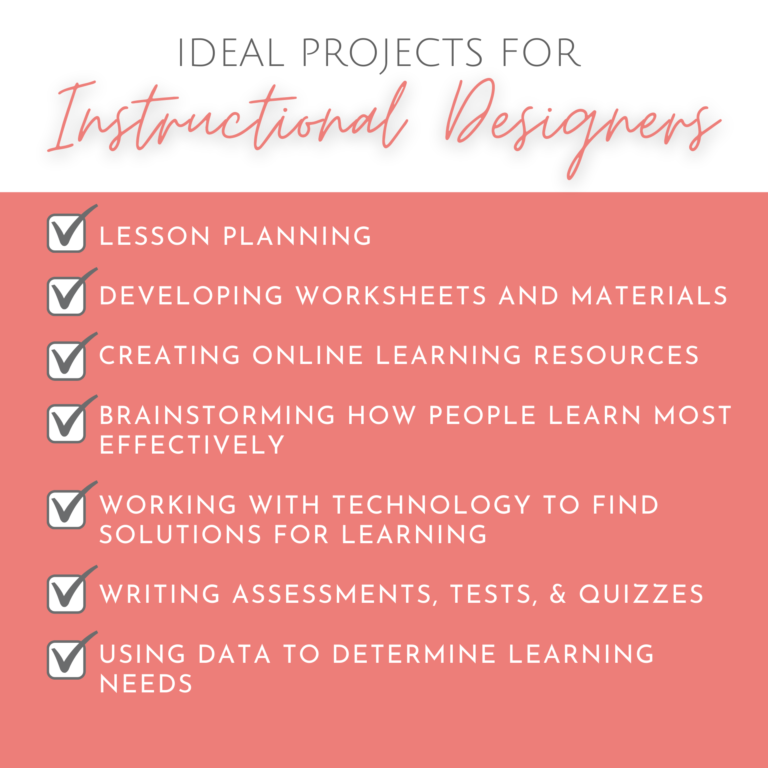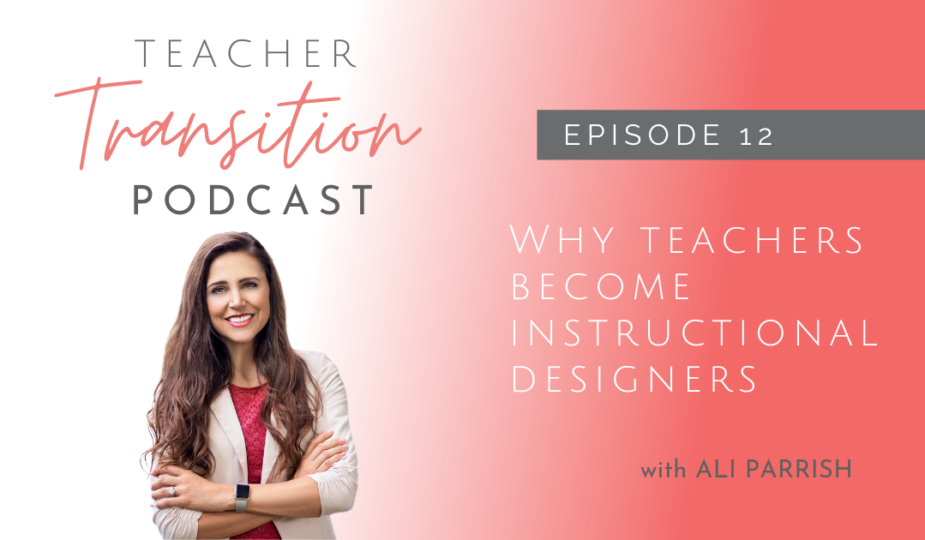The Show Notes
There’s always a reason teachers fall in love with their profession. Even if every part of teaching doesn’t excite you as much anymore, some teachers are really naturally gifted at things like:
- Determining learning objectives
- Identifying how the objectives will be taught
- Creating a scope and sequence for learning material
- Creating the learning resources to go with a lesson
If you could limit your work to these types of projects, would that energize or excite you to go to work each day? If so, today’s episode is going to help you see how valuable your strengths are as an instructional designer!
In this episode, I am sharing all about the specifics about the role of an instructional designer and exactly why classroom teachers thrive in this position!
Instructional Design: A Natural Next Step for Teachers
Many teachers looking for another career have considered becoming a curriculum designer before. But what it is important to understand is that your skill set as a teacher is not just limited to the world of education.
Any business that has to develop materials to train employees utilizes an instructional designer. Though you may not be using grade level standards as your guide, your experience as a teacher is still incredibly valuable to the organizations who hire for these roles.
In the next few episodes, you’re going to hear from five former teachers who have transitioned into instructional design. You’ll learn what kinds of places they work, and what kinds of projects they work on. You’ll even hear exactly what their transition path looked like and why they love the work they do now. Let me give you a sneak peak into their stories!
Meet Melanie
Melanie was a teacher for many years. She had a true gift for planning lessons that were well aligned with objectives and highly engaging for students. She regularly got excellent feedback from parents, students, and co-workers that she was really great at what she did.
Melanie became an instructional designer at an educational company and began creating materials for teachers and students including things like assessments and a scope and sequence for the curriculum. Melanie is responsible for reverse engineering the materials for lessons so that they support all the objectives set out for students along the way. Are you good at these types of projects too?
On a typical day, Melanie even gets to create teacher manuals, activities, online resources, videos, and worksheets. Melanie loves what she does because she feels like she is a valuable asset to her team. Her experience as a teacher makes her a very credible resource to her company!
Meet Cheryl
Cheryl was a teacher who was really involved with ed tech. She found herself pursuing the ideas of a career beyond the classroom for a few reasons. She had a desire to continue developing her skill set, but also to provide herself with a little more job security.
So after taking the instructional design course, she put her resume out there and rather quickly landed a job at a local university. In this role, Cheryl supports professors by giving them strategies to teach more effectively. She also helps manage the needs that pop up with online learning platforms. Cheryl gets to create videos and instructional materials that are available for online learning.
One of the best perks of her job is that Cheryl now makes considerably more income than she did as a teacher. She also has a whole new skill set in her tool belt in the event she ever has plans to start her own business as an instructional designer!

Meet Janna
Janna was a teacher who loved the profession and it came really naturally to her. But as she was looking forward to her dreams of having a family, she wisely considered options that would allow her to be more present as a mom and a wife.
Janna landed her first job in instructional design shortly after taking the course, From Teacher to Instructional Designer. Now she works for a company that is responsible for creating materials for new hire trainings. At a starting salary, Janna now makes about $20K more than she did at the end of her teaching career.
For Janna, the biggest perk about instructional design is that her work is flexible. Like Cheryl, she has developed a whole new skill set that has made her much more marketable if she needs to pivot again.
Meet Annie
Annie was a teacher who had already received a master’s degree in teaching. Annie learned rather quickly that getting a master’s in teaching didn’t equate with a new job. Once she learned how to become an instructional designer in the course, she connected with a local agency.
The exciting part about working with an agency is that you can work with a large variety of clients and businesses. In her role, Annie is responsible for writing lessons, creating workbooks, and even writing scripts for advertisements and learning videos. She also creates assessments, PowerPoints, and training guides. Does this sound like a good fit for you?
Meet Lacey
Lacey only taught for a few years before realizing that she had a strong desire for a more flexible work schedule so she could be at home with her kids. She knew that she still wanted to work and even still use her teaching skills, so being an instructional designer was a natural next step.
Lacey decided that working part-time would be best when she first got started, but then she realized she needed even more freedom and flexibility. At that point, Lacey took her training and used it to strike out on her own.
Lacey says working for herself is so fulfilling because she only says yes to the work that interests her the most. Her clients have offered her the feedback that her background makes her incredibly trustworthy. Her classroom experience also made her an expert.
How to Take the First Step Towards Your Future in Instructional Design
So when it comes to teaching, what are your top strengths and interests? Take a moment to make a list. Which one of these instructional design jobs meets your needs and interests most? What type of setting would be the most ideal for your next job? Write those down too!
And lastly, I want you to take a moment and ask yourself, “Where do I want to be six months from now?” Teaching is not a profession you can leave overnight. Contracts and the investment we make in the lives of people we work with make it a decision we need to make carefully and well in advance. But if you were to quit at the end of this year or this semester would you have a plan?
Some of the students in the instructional design course landed a job within the first month. Others took more like three months. But they only got there because they made a decision. Investing in themselves by enrolling in the course allowed them to fast track their success without getting a master’s degree.
I can’t wait for you to hear from each of these students, their own stories of transition beyond the classroom, and what they love most about their jobs now. Until then, what are YOU curious about when it comes to instructional design?
Ready to Become an Instructional Designer Too?

A Breakdown of This Episode:
- [2:30] Discover the difference between a curriculum developer and an instructional designer
- [07:15] Learn what makes an instructional design role so fulfilling for former teachers
- [11:45] Learn how quickly Janna was able to find a job in instructional design after taking the course
- [16:13] Find out why a career in instructional design can be flexible, allowing you to support your family
- [21:46] The question you need to be asking yourself if instructional design sounds like a great fit for you
If you enjoyed this episode I invite you to take a screenshot and tag me on your Instagram stories @teachertransition and tell me your biggest takeaway!
Want to know what other work opportunities you might love beyond the classroom? Click here to get the FREE Top Jobs for Teachers download.
Have you joined the Podcast Facebook Community yet?
This episode may be over, but connecting doesn’t have to! Come join us each week to share your takeaways from this week’s episode. Let this community help brainstorm with you and help you get one step closer to your next career!
Resources Mentioned in the Show
- Teacher Transition Website
- Ready to dive into YOUR career in instructional design? Click HERE to enroll in the course- From Teacher to Instructional Designer today!
- Wondering if you’d like working in instruction design? Take the “Would I Enjoy Being an Instructional Designer” Quiz to find out!
